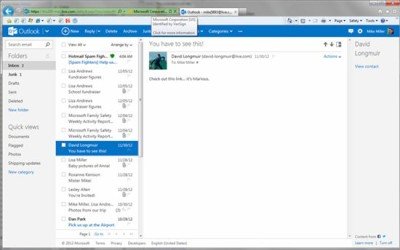Microsoft believes protecting its users from any sort of phishing and spam attacks is the company’s priority. It has therefore heightened security at its new mail service Outlook.com. It has added support for DMARC and EV certificates. Both the features would help customer fight against common phishing attacks and provide them with even more protection while sending and reading mails.

Outlook.com DMARC Support
This feature is actually a reporting standard that helps you visually identify mail from senders as legitimate or illegitimate. If illegitimate, the feature helps keep sender’s fake messages away from ever reaching your inbox. On the other hand, if a sender supports DMARC, a trusted sender logo is placed next to his email indicating it is legitimate, thereby assuring you complete protection against phishing attacks.
EV Certificates (Extended Validation Certificates) support
The feature when implemented takes SSL connection to a new level. SSL technology is an important technology for protecting against phishing, but some were registered recently where even some SSL certificates were compromised. This allowed attackers to impersonate SSL sites and escape unnoticed. On learning this, Microsoft included EV Certificate support in its web mail service.
Extended Validation Certificates help in avoiding instances of phishing attacks by preventing malicious sites from masquerading as the trusted service. These certificates require a minimum of 2048-bit encryption, far more secure than what is commonly used with standard SSL. It makes sure the website you are interacting with is a trusted website and the information you have shared with it is safe. The green address bar that you may find in your browser is just indicative of that assurance. Microsoft has chosen one of the most-trusted Certificate Authorities (CA) to issue its EV certificates–Symantec.
Currently, these enhancements have been rolled out just for Outlook.com. It would be extended to other services such as SkyDrive and more in the coming days, reports the Outlook Blog.
Leave a Reply